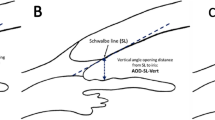Abstract
Purpose
To compare Hong’s grading method with anterior segment optical coherence tomography (AS-OCT), gonioscopy, and the dark-room prone-position test (DRPT) for evaluating anterior chamber width.
Methods
The anterior chamber angle was graded using Hong’s grading method, and Hong’s angle width was calculated from the arctangent of Hong’s grades. The correlation between Hong’s angle width and AS-OCT parameters was analyzed. The area under the receiver operating characteristic curve (AUC) for Hong’s grading method when discriminating between narrow and open angles as determined by gonioscopy was calculated. Correlation analysis was performed between Hong’s angle width and intraocular pressure (IOP) changes determined by DRPT.
Results
A total of 60 subjects were enrolled. Of these subjects, 53.5 % had a narrow angle. Hong’s angle width correlated significantly with the AS-OCT parameters (r = 0.562–0.719, P < 0.01). A Bland–Altman plot showed relatively good agreement between Hong’s angle width and the angle width obtained by AS-OCT. The ability of Hong’s grading method to discriminate between open and narrow angles was good (AUC = 0.868, 95 % CI 0.756–0.942). A significant linear correlation was found between Hong’s angle width and IOP change determined by DRPT (r = −0.761, P < 0.01).
Conclusions
Hong’s grading method is useful for detecting narrow angles. Hong’s grading correlated well with AS-OCT parameters and DRPT.





Similar content being viewed by others
References
Foster PJ. The epidemiology of primary angle closure and associated glaucomatous optic neuropathy. Semin Ophthalmol. 2002;17:50–8.
Foster PJ, Baasanhu J, Alsbirk PH, Munkhbayar D, Uranchimeg D, Johnson GJ. Glaucoma in Mongolia. A population-based survey in Hövsgöl province, northern Mongolia. Arch Ophthalmol. 1996;114:1235–41.
Johnson GJ, Foster PJ. Can we prevent angle-closure glaucoma? Eye. 2005;19:1119–24.
Dandona L, Dandona R, Mandal P, Srinivas M, John RK, McCarty CA, et al. Angle-closure glaucoma in an urban population in southern India. The Andhra Pradesh Eye Disease Study. Ophthalmology. 2000;107:1710–6.
Radhakrishnan S, Goldsmith J, Huang D, Westphal V, Dueker DK, Rollins AM, et al. Comparison of optical coherence tomography and ultrasound biomicroscopy for detection of narrow anterior chamber angles. Arch Ophthalmol. 2005;123:1053–9.
Dada T, Sihota R, Gadia R, Aggarwal A, Mandal S, Gupta V. Comparison of anterior segment optical coherence tomography and ultrasound biomicroscopy for assessment of the anterior segment. J Cataract Refract Surg. 2007;33:837–40.
Van Herick W, Shaffer RN, Schwartz A. Estimation of width of angle of anterior chamber. Incidence and significance of the narrow angle. Am J Ophthalmol. 1969;68:626–9.
Kang SH, Park KH, Hong C, Kim DM. The clinical usefulness of the Hong’s grading method. J Korean Ophthalmol Soc. 2007;48:399–404.
Park SB, Sung KR, Kang SY, Jo JW, Lee KS, Kook MS. Assessment of narrow angles by gonioscopy, Van Herick method and anterior segment optical coherence tomography. Jpn J Ophthalmol. 2011;55:343–50.
Kim M, Park KH, Kim TW, Kim DM. Changes in anterior chamber configuration after cataract surgery as measured by anterior segment optical coherence tomography. Korean J Ophthalmol. 2011;25:77–83.
Kim TW, Park KH, Hong C. Dark-room prone-position test for intermittent angle closure. Korean J Ophthalmol. 2007;21:151–4.
Radhakrishnan S, Rollins AM, Roth JE, Yazdanfar S, Westphal V, Bardenstein DS, et al. Real-time optical coherence tomography of the anterior segment at 1310 nm. Arch Ophthalmol. 2001;119:1179–85.
Friedman DS, He M. Anterior chamber angle assessment techniques. Surv Ophthalmol. 2008;53:250–73.
Wang B, Congdon NG, Wang N, Lei K, Wang L, Aung T. Dark room provocative test and extent of angle closure: an anterior segment OCT study. J Glaucoma. 2010;19:183–7.
Hyams SW, Friedman Z, Neumann E. Elevated intraocular pressure in the prone position. A new provocative test for angle-closure glaucoma. Am J Ophthalmol. 1968;66:661–72.
Harris LS, Galin MA. Prone provocative testing for narrow angle glaucoma. Arch Ophthalmol. 1972;87:493–6.
Sihota R, Mohan S, Dada T, Gupta V, Pandey RM, Ghate D. An evaluation of the darkroom prone provocative test in family members of primary angle closure glaucoma patients. Eye. 2007;21:984–9.
Acknowledgments
This study was supported by a grant from the Boramae Medical Center Research Fund (2011).
Author information
Authors and Affiliations
Corresponding author
About this article
Cite this article
Kim, S.H., Kang, J.H., Park, K.H. et al. Hong’s grading for evaluating anterior chamber angle width. Jpn J Ophthalmol 56, 551–558 (2012). https://doi.org/10.1007/s10384-012-0180-1
Received:
Accepted:
Published:
Issue Date:
DOI: https://doi.org/10.1007/s10384-012-0180-1




